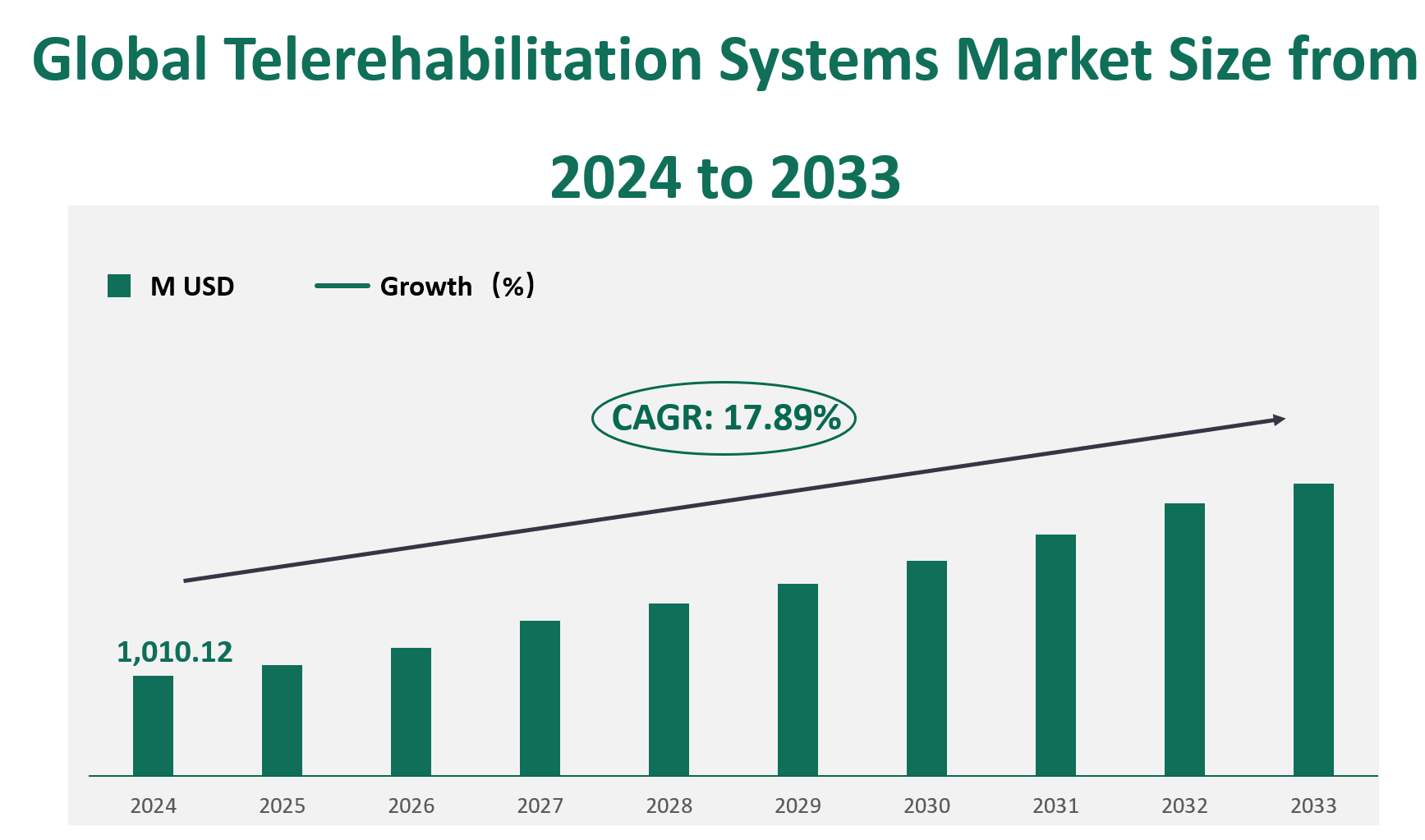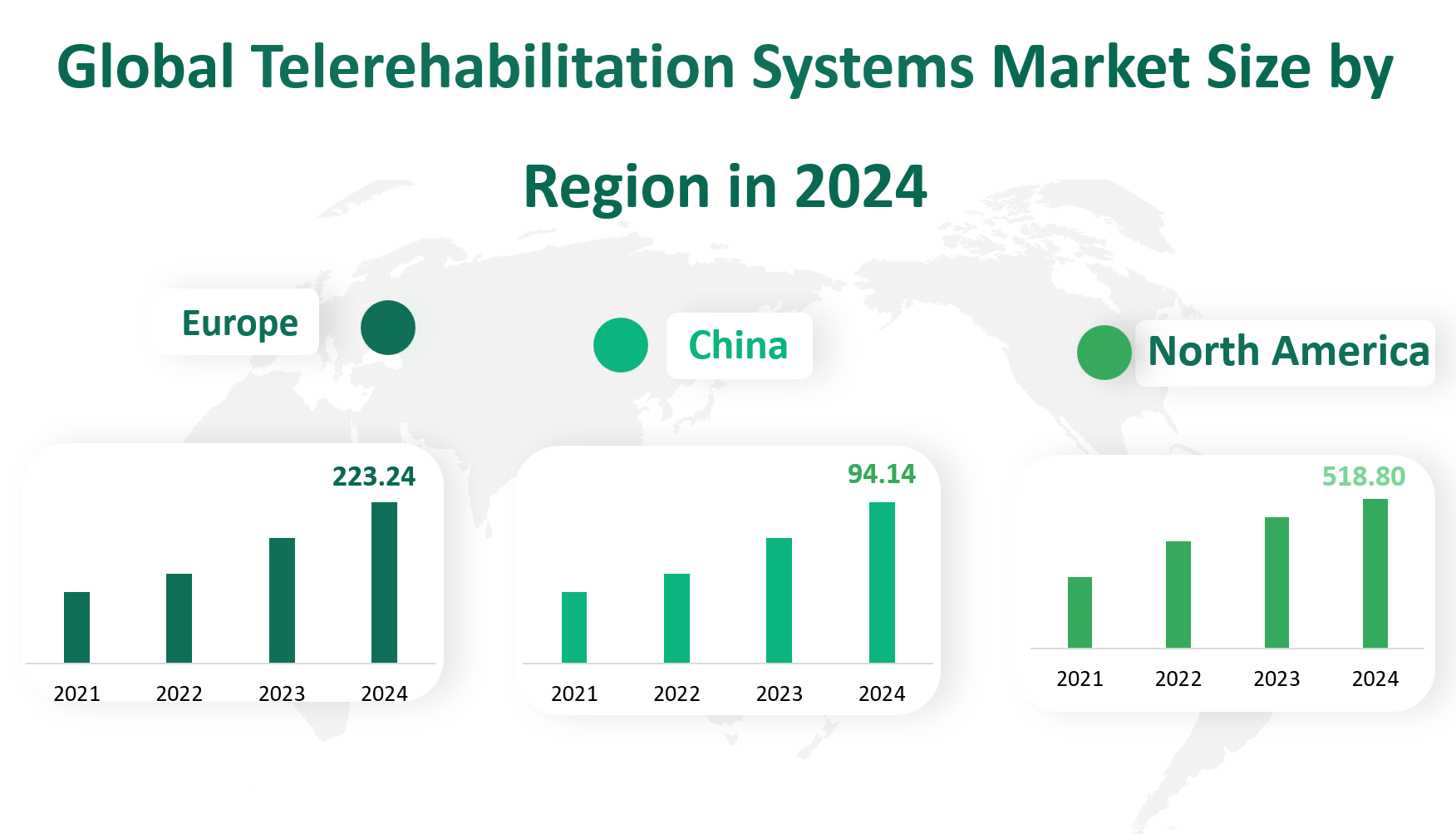1. Global Telerehabilitation Systems Market Insight Analysis
The global Telerehabilitation Systems market value is projected to reach $1,010.12 million USD by 2024, with a robust compound annual growth rate (CAGR) of 17.89% from 2024 to 2033.
Telerehabilitation Systems refer to the use of telecommunication technologies to provide rehabilitation services remotely. These systems integrate hardware and software solutions to enable healthcare providers to deliver therapy and support to patients in their homes or other remote locations. The hardware components include speakers, microphones, wireless sensors, routers, and other devices, while the software components manage sessions, control cameras, and display sensor data. This technology allows for continuous monitoring and personalized care, enhancing the overall effectiveness of rehabilitation programs.
Figure Global Telerehabilitation Systems Market Size (M USD) and CAGR (2024-2033)

2. Driving and Limiting Factors of Telerehabilitation Systems Market Growth
The growth of the Telerehabilitation Systems market is influenced by several key drivers and limiting factors. On the positive side, the increasing number of patients with chronic diseases and cancer is a significant driver. Chronic obstructive pulmonary disease (COPD) and other chronic conditions are leading causes of morbidity and mortality worldwide, driving the need for remote rehabilitation programs. Additionally, the growing aging population and the increasing incidence of chronic diseases are pushing the demand for advanced healthcare services like telerehabilitation.
Another major driver is the technological advancements in internet connectivity and digital health solutions. The development of reliable and high-speed internet infrastructure has made it possible to deliver high-quality rehabilitation services remotely. Furthermore, the increasing adoption of telehealth benefits by insurance providers, such as the US Bipartisan Budget Act of 2018, has expanded the accessibility and reimbursement for telerehabilitation services.
However, there are also several limiting factors that could hinder the market’s growth. One significant challenge is the imbalance between the large number of patients and the understaffing in health centers. This issue is particularly pronounced in rural areas where access to healthcare providers is limited. Additionally, the complexity of implementing remote rehabilitation solutions, including the need for stable internet connections and the high costs associated with system optimization, can be barriers to widespread adoption.
3. Technology Innovation and Corporate Mergers and Acquisitions in Telerehabilitation Systems Market
The Telerehabilitation Systems market is experiencing rapid technological innovation and significant corporate activity. Companies are continuously developing new hardware and software solutions to enhance the effectiveness and accessibility of remote rehabilitation services. For example, companies like Cisco, Resideo Life Care Solutions (Honeywell), and Philips Healthcare are leading the way in providing advanced telehealth solutions that integrate seamlessly with existing healthcare systems.
In addition to technological advancements, the market has seen several notable mergers and acquisitions. For instance, Philips Healthcare completed the acquisition of Carestream Health’s Healthcare Information Systems business in 2019, expanding its enterprise diagnostic informatics solutions. Similarly, Appello acquired Medvivo’s Careline business in 2019, significantly growing its telecare monitoring services. These strategic moves reflect the industry’s focus on consolidating expertise and expanding market reach.
Furthermore, the market is also witnessing the entry of new players and the expansion of existing ones into new regions. Companies are leveraging emerging markets like China and India, where there is significant potential for growth due to increasing disposable incomes and a growing demand for advanced healthcare solutions. The combination of technological innovation and strategic corporate actions is expected to further drive the market forward, making telerehabilitation services more accessible and effective for patients worldwide.
4. Global Telerehabilitation Systems Market Size by Type
Telerehabilitation Systems encompass a range of technologies designed to provide remote rehabilitation services to patients. These systems can be broadly categorized into two main types: Hardware and Software.
Hardware components of Telerehabilitation Systems include devices such as speakers, microphones, wireless sensors, routers, and other peripheral equipment. These devices are essential for facilitating real-time communication and data transmission between patients and healthcare providers. The hardware market is driven by the need for reliable and high-quality equipment that can support various rehabilitation programs, from physical therapy to cognitive rehabilitation.
The Hardware market is projected to be worth $565.37 million in 2024, accounting for approximately 55.97% of the total market value.
Software components of Telerehabilitation Systems include session management tools, camera controls, sensor displays, and other applications designed to enhance the rehabilitation experience. These software solutions enable healthcare providers to monitor patient progress, customize treatment plans, and provide real-time feedback. The software market is characterized by continuous innovation, with companies developing advanced algorithms and user-friendly interfaces to improve patient engagement and outcomes.
The Software segment is also expected to experience substantial growth, reaching a market value of $444.76 million by 2024.
Table Global Telerehabilitation Systems Market Size by Type in 2024
5. Global Telerehabilitation Systems Market Size by Application
Telerehabilitation Systems are applied across various segments of the healthcare industry, each with its unique requirements and opportunities. The primary applications include Service Providers, Payers, and Patients/Clients.
Service Providers include hospitals, clinics, and other healthcare facilities that offer rehabilitation services. These providers utilize Telerehabilitation Systems to extend their reach beyond traditional clinical settings, enabling remote monitoring and treatment of patients. By adopting these systems, service providers can improve patient engagement, reduce readmission rates, and enhance overall care outcomes. The Service Providers segment is also expected to experience substantial growth, reaching a market value of $346.37 million by 2024.
Payers consist of insurance companies, government healthcare programs, and private payers. These entities are increasingly recognizing the cost-effectiveness of Telerehabilitation Systems in reducing healthcare expenditures while maintaining high-quality care. By covering the costs of remote rehabilitation services, payers can promote the adoption of these systems, benefiting both patients and healthcare providers. The Payers segment is projected to be worth $64.65 million in 2024, accounting for 6.40% of the total market value.
Patients and clients are the end-users of Telerehabilitation Systems, benefiting from the convenience and accessibility of remote rehabilitation services. These systems allow patients to receive personalized care in the comfort of their homes, reducing the need for frequent visits to healthcare facilities. This not only saves time and resources but also improves patient satisfaction and adherence to rehabilitation programs.
The Patients/Clients segment is expected to hold the largest market share. This segment is projected to be worth $599.10 million in 2024, accounting for approximately 59.31% of the total market value.
Table Global Telerehabilitation Systems Market Size by Application in 2024
Application | Market Size (M USD) 2024 |
Service Providers | 346.37 |
Payers | 64.65 |
Patients/ Clients | 599.10 |
6. Global Telerehabilitation Systems Market by Top Regions
North America is expected to remain the largest market by revenue in 2024, with a projected market value of $518.80 million. This region has a strong technical foundation, a well-developed healthcare infrastructure, and a high demand for advanced healthcare solutions. The United States, in particular, is a leader in market capacity, technological strength, and innovation.
Europe is the second-largest market, projected to reach $223.24 million by 2024. The region benefits from a strong technical foundation and a well-developed healthcare system. The European Union’s GDP and robust healthcare policies support the adoption of Telerehabilitation Systems.
China is projected to be the fastest-growing region in the Telerehabilitation Systems market, with a projected market value of $94.14 million by 2024. The rapid growth in China is driven by its large population, increasing disposable income, and the government’s focus on improving healthcare infrastructure.
Japan is projected to have a market value of $59.19 million by 2024. The country has a well-developed healthcare system and a strong focus on technological innovation.
The Middle East & Africa region is projected to have a market value of $25.86 million by 2024. The region is characterized by a diverse economy and significant investment in healthcare infrastructure.
India is projected to have a market value of $21.21 million by 2024. The country has a large population and a rapidly growing economy.
South America is projected to have a market value of $24.75 million by 2024. The region has a rapidly developing economy and a growing healthcare market.
Figure Global Telerehabilitation Systems Market Size by Region in 2024

7. Global Telerehabilitation Systems Market Analysis by Major Players
7.1 Cisco Company
Introduction and Business Overview Cisco Systems, Inc. is a global leader in Internet solutions, providing a wide range of equipment and software products for network systems. Founded in 1984, Cisco offers broadband cable products, network management, fiber optic platforms, routers, switches, network security products, and more. The company is committed to providing network and digital solutions for various industries, including healthcare.
Products Offered Cisco’s Telerehabilitation Systems include telehealth and collaboration solutions that enable remote care. These solutions break the boundaries that separate remote healthcare teams, empowering clinicians to communicate and work collaboratively with patients and colleagues across different locations.
7.2 Resideo Life Care Solutions (Honeywell) Company
Introduction and Business Overview Resideo Life Care Solutions, a division of Honeywell, is a leading provider of remote patient monitoring solutions. Founded in 1999, the company offers advanced and integrated solutions for telehealth and telecare, including monitoring services, remote patient management applications, decision support, and disease management.
Products Offered Resideo’s LifeStream Clinical Monitoring Software allows clinicians to manage the health status of monitored patients from a single dashboard, receive alerts, remotely program monitor settings, and initiate video visits.
7.3 Philips Healthcare Company
Introduction and Business Overview Philips Healthcare is a global leader in health technology, offering a wide range of solutions for diagnosis, treatment, and home care. Founded in 1891, Philips is committed to improving the health continuum through innovative solutions that enable better care at lower costs.
Products Offered Philips’ Telerehabilitation Systems include virtual care enablement, care coordination, and population health management consulting. These solutions leverage centralized approaches to support care coordinators and managers in implementing proactive interventions and care plans.

